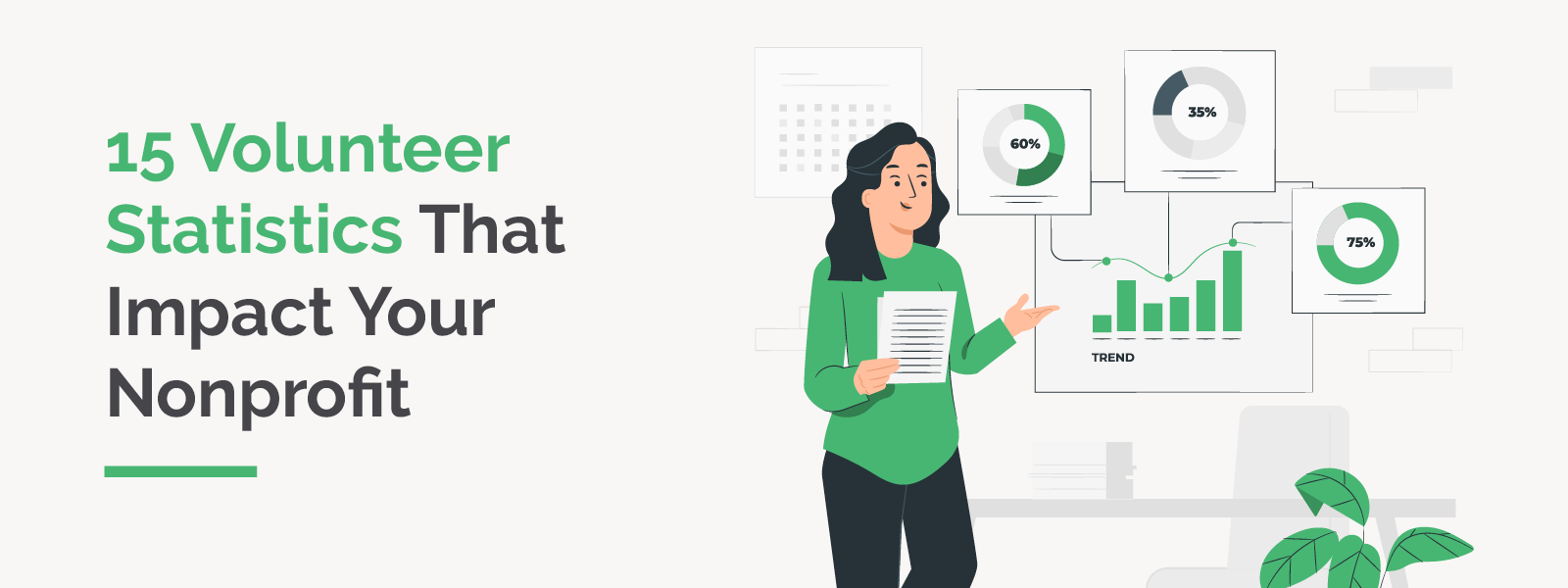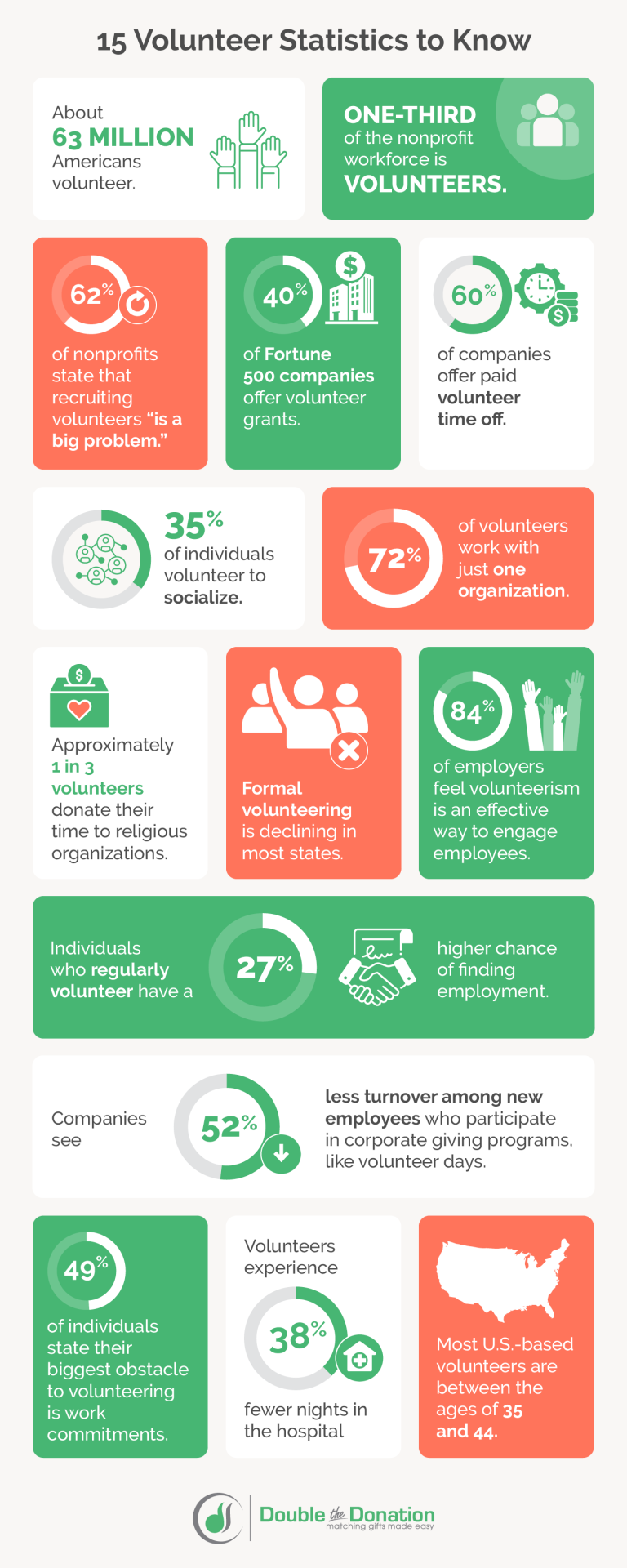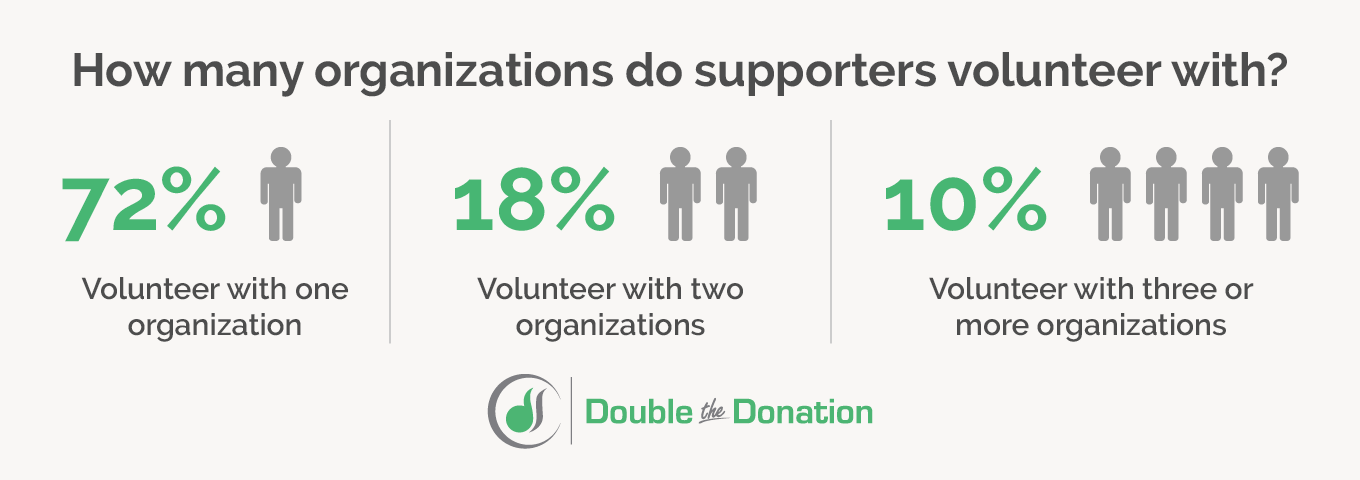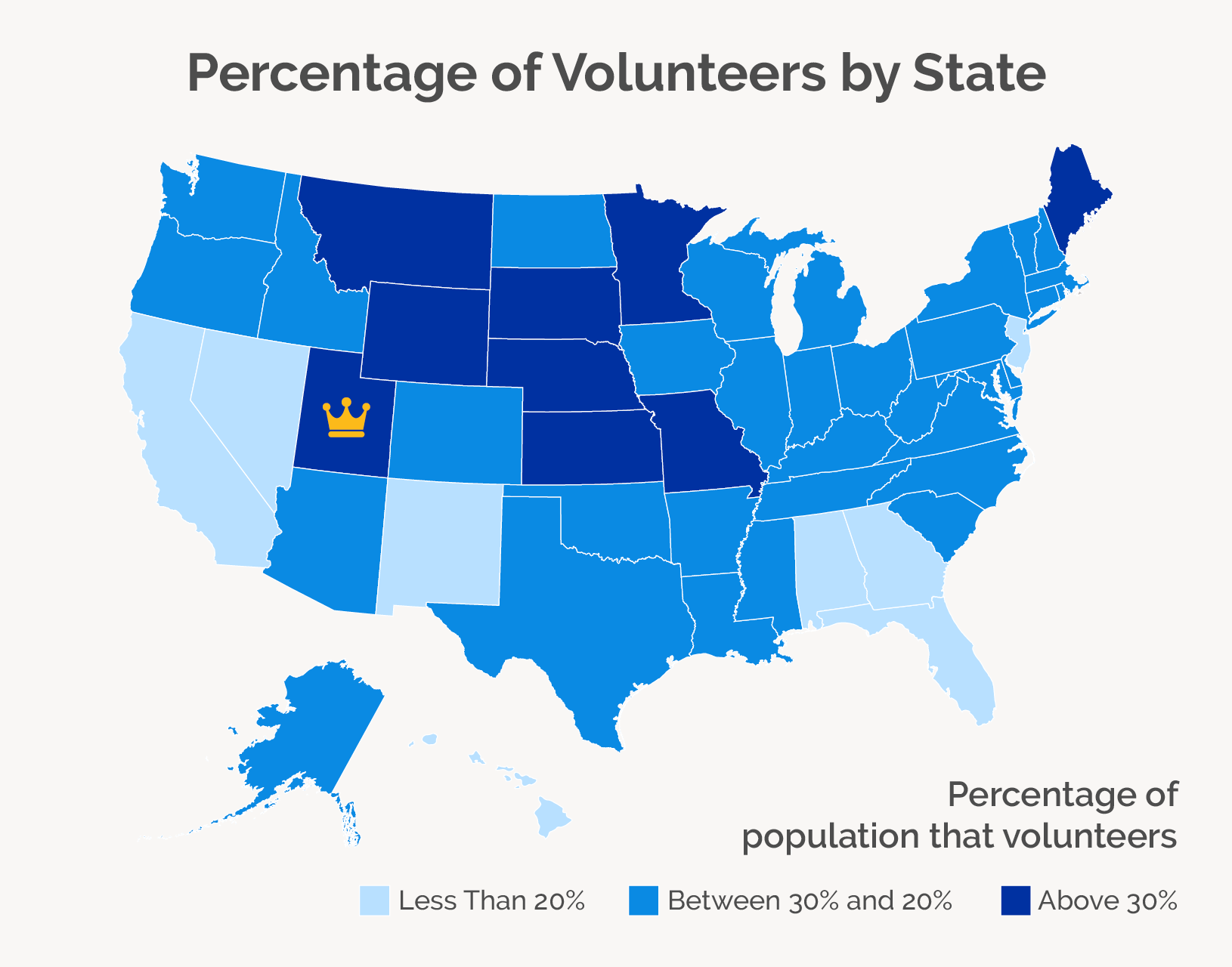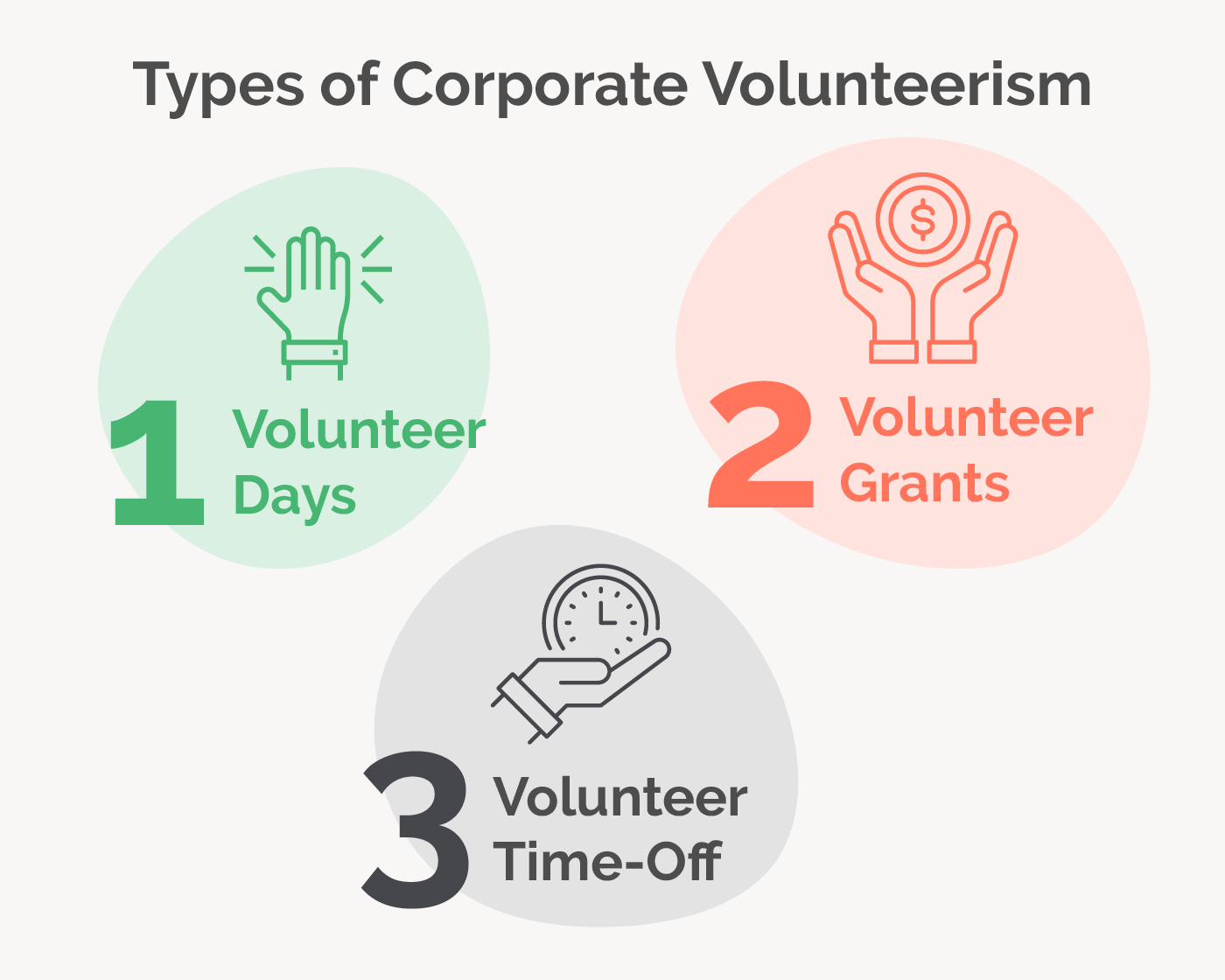15 Volunteer Statistics That Impact Your Nonprofit
Volunteers are a core part of your nonprofit’s team, handling responsibilities ranging from event management and bookkeeping to on-the-ground work at your program sites. These volunteers help out for a number of reasons, such as wanting to help a good cause or joining in as part of their corporate team.
When solidifying your volunteer program’s recruitment strategies, remember to not look not just at data from prior years but at the nonprofit landscape as a whole. Larger trends in volunteer behavior and motivations can directly influence your ability to attract and retain enough volunteers to maintain your programs.
To help your nonprofit understand your volunteers a bit more, this guide will take a deep dive into 15 volunteer statistics.
While these statistics can be informative, remember that they depend on many factors, not all of which may apply to your nonprofit. A lot goes into volunteer management, including ample appreciation, effective communication, and inspiring marketing. Of course, trends like these are still useful for understanding where your organization fits into the wider nonprofit landscape.
1. About 63 million Americans volunteer.
For U.S.-based nonprofits, volunteers are everywhere. In fact, about 63 million Americans volunteer their time and energy. For reference, that’s around 25% of the adult population. Looking at the wider world, that number only goes up with a total of over 1 billion people volunteering across the globe.
What does this volunteer statistic mean for your nonprofit? Finding people who are able and willing to lend their time is possible, even if it can sometimes feel like your stream of volunteer applicants is more of a trickle than a river. While some individuals will sign up to volunteer of their own volition, others require more of a push. In fact, many volunteers just need to be asked by a nonprofit to help out simply because signing up on their own hadn’t occurred to them.
2. One-third of the nonprofit workforce is volunteers.
Your nonprofit’s staff are instrumental in providing beneficiaries with the services and assistance they need. However, most nonprofits have tight budgets and rely on volunteer labor. This is so much the case that one-third of all nonprofit workers are volunteers.
Of course, the ratio of paid employees to volunteers will vary from nonprofit to nonprofit. Many small local organizations do incredibly important work but are entirely made up of volunteers or only have an executive director who organizes everything. In contrast, enterprise-size nonprofits have entire departments of paid employees.
What does this mean for your nonprofit? Because so much labor at nonprofit organizations goes unpaid, calculations of the nonprofit sectors’ economic value will always be off. Don’t let this impact how your nonprofit values your volunteers, however. Show your appreciation and ensure they feel like they’re a real part of your team because, ultimately, the numbers show that they are!
3. 62% of nonprofits state that recruiting volunteers is “a big problem.”
Nonprofits need volunteers to staff events, help during fundraisers, and complete tasks that keep their programs running. However, finding enough people to fill all available volunteer positions isn’t always easy, and 62% of nonprofit CEOs state that recruiting enough volunteers is an issue. This goes hand-in-hand with additional data that the demand for many nonprofit services is up.
What does this volunteer statistic mean for your nonprofit? A wide range of reasons impact volunteer recruitment, and the nonprofit industry as a whole tends to see fluctuations over time depending on global factors out of their control. For example, volunteer rates tend to rise during times of crisis as individuals step up to provide community relief.
Of course, there are factors your nonprofit can control. Consider what roles you have open for volunteers and how you promote them. Are these roles volunteers would be interested in, or are they positions that are mostly rote work? While many individuals volunteer to give back, remember to emphasize the other benefits volunteers can gain by helping out.
Additionally, if you’re constantly having to find new volunteers, that might be a sign to take a step back and assess your volunteer retention strategy. Talk with these volunteers about improvements to your program they’d like to see and show your appreciation. Even if you’re low on staff, make sure not to overwork them to avoid burnout, too.
4. 40% of Fortune 500 companies offer volunteer grants.
Have you heard of corporate volunteer grants before? Certain corporations encourage their employees to volunteer by promising to donate to the nonprofits their employees help out at.
Here’s a breakdown of how the volunteer grant process usually works:
- An employee volunteers at an eligible nonprofit. Many employers who provide volunteer grants have certain requirements for what charitable organizations they’ll support. For example, many employers exempt religious organizations from receiving volunteer grants.
- The employee reports their volunteer hours and other needed information. Most employee volunteer grant programs are based on the hours an employee volunteers. Some provide a per-hour rate while others require a certain hours threshold to be met and then donate a flat amount. Additionally, employers need information about the nonprofit, like its name, tax ID, and mailing address.
- The company donates to the nonprofit. Once a volunteer grant application is submitted, the company reviews it. If the nonprofit and hours requirements have been met, the grant application is improved, and the nonprofit receives a donation.
How widespread are volunteer grant programs? 40% of Fortune 500 companies offer this type of corporate giving. That means several volunteers who already help at your nonprofit might qualify for a grant.
What does this volunteer statistic mean for your nonprofit? Start educating your volunteers about the power of volunteer grants. Keep careful track of their hours, and help them discover if they’re eligible. Most employers will have the relevant information accessible through their CSR portal or in their office handbook. If you can’t find any information there, it also never hurts to ask!
5. 60% of companies offer paid volunteer time off.
Another way companies give back to nonprofits is through volunteer time off (VTO). Around 60% of companies provide employees with paid VTO days each year. This perk is growing in popularity, and an additional 21% of companies have ambitions to implement a VTO policy as early as 2024.
What does this volunteer statistic mean for your nonprofit? Encourage employees to take a closer look at their employer benefits. If they have paid VTO they’re not taking, they’re leaving money on the table for your nonprofit and depriving themselves of rightfully earned time off.
6. 35% of individuals volunteer to socialize.
Volunteers donate their time to nonprofits for all sorts of reasons, but one group to keep an eye on is the 35% of individuals who volunteer to socialize. While this group is not the majority (that would be the 83% who volunteer to help a cause they care about), there are a few interesting things about them.
Specifically, social volunteers volunteer more frequently than others and tend to volunteer with more than one organization, which as the next few statistics will show, is not the norm. For these volunteers, the community your nonprofit builds is what matters and what makes them dedicated to your cause.
What does this volunteer statistic mean for your nonprofit? In your recruitment materials, discuss the work volunteers will do, the qualifications they need, and work expectations as normal, but don’t neglect to mention all the benefits they can receive as well. Discuss your volunteer community and feature images of volunteers at work so potential recruits can picture themselves alongside the rest of your team.
7. Individuals who regularly volunteer have a 27% higher chance of finding employment.
Volunteering is good for nonprofits and good for volunteers. Along with finding a community, volunteer opportunities are also learning opportunities where individuals can learn new skills, make connections, and improve themselves. Considering these benefits, it may not come as a surprise that jobseekers who volunteer have a 27% higher rate of finding employment.
What does this volunteer statistic mean for your nonprofit? As discussed earlier, it’s easy to focus solely on how volunteering helps the nonprofit recruit supporters. However, while volunteers do want to help causes they care about, it also never hurts to mention the benefits they can receive in addition to making a positive impact.
Be upfront about the skills and experience supporters can gain from volunteering. This can include anything from customer service experience, data management, specific labor and technical skills, or anything else related to your programs that’s also applicable in the workplace.
8.72% of volunteers work with just one organization.
Volunteering takes time and effort, which may explain why it’s not surprising that 72% of volunteers work with only one charitable organization and just 18% are involved with two.
Most volunteers choose which organizations to donate their time to based on their connection to a specific cause. Logically, if a volunteer finds a nonprofit they feel does good work for their target issue, why wouldn’t they stay put? Plus, with the time commitments of just researching new nonprofits to join, switching volunteer positions takes effort.
What does this volunteer statistic mean for your nonprofit? While your nonprofit should certainly partner with other charitable organizations to complete projects and improve services, know that efforts to poach volunteers likely won’t be successful or appreciated.
Instead, focus on the volunteers you have. These volunteers can become deeply loyal to the causes they care about, and in exchange, all your nonprofit needs to do is continue fulfilling its mission, show volunteers respect and appreciation, and continue providing worthwhile opportunities to get involved.
9. Approximately 1 in 3 American volunteers donate their time to religious organizations.
Volunteers work for a wide range of causes at nonprofits, schools, churches, and other types of organizations. However, the highest percentage of volunteers in America donate their time to religious organizations. The percentage lands at about 32%, which equates to 1 in every 3 American volunteers.
This continues to track when broken down on a state level with Utah having the highest percent of its population (51%) volunteer, many of whom participate in volunteer opportunities provided through their churches.
What does this volunteer statistic mean for your nonprofit? If your nonprofit isn’t a church, these numbers might not seem like they matter at first glance. However, churches commonly partner with or conduct volunteer activities that have little to do with religion. For example, a church group might volunteer together at a food bank, or a church might help fundraiser for a homeless shelter.
When considering organizations your nonprofit can partner with, don’t rule out religious groups as many of them have members who are ready and eager to support a good cause.
10. Formal volunteering is declining in most states.
If your nonprofit has had trouble filling volunteer positions, know that you’re not alone. The majority of U.S. states have seen a decrease in the percentage of their population that formally volunteers. For example, in Florida, already a state with low volunteering rates, 22.8% of the population volunteered in 2017. Four years later, it’s just 15.9%.
How much volunteering has declined varies from state to state, with some following routine ebbs and flows, while others have experienced as much as a 10% drop.
What does this volunteer statistic mean for your nonprofit? Volunteering percentages are impacted by several factors, such as more people coming out to volunteer during state emergencies like hurricanes or wildfires. However, nonprofits should take notice when rates are consistent across the board like they are for this decline.
What can nonprofits do about declining volunteer rates? For some, this might be a sign that it’s time to rework their recruitment strategy to target new audiences. Adjust how your nonprofit promotes itself to connect with younger audiences, or reconsider how you’re positioning your nonprofit’s mission. Do today’s volunteers care about the same causes they did ten years ago, or have their priorities shifted?
Take the time to survey your supporters and conduct audience research to learn what potential volunteers in your state are looking for in a nonprofit and how you can reach out to them.
11. 84% of employers feel volunteerism is an effective way to engage employees.
Volunteering isn’t always arranged just between the supporters and a nonprofit organization. Trends in the corporate sector reveal that many businesses are getting more serious about corporate social responsibility (CSR), and volunteer programs are a major component of that. In fact, 84% of employers feel volunteerism is an effective way to engage their employees.
Employee engagement programs like volunteer days allow workers to feel connected to their communities. Rather than just donating and hoping their money is put to good use, they can take an active role in helping local nonprofits fulfill their missions. This increases their connection to the causes nonprofits champion and improves their feelings for the employers who put them in contact with these charitable organizations.
What does this volunteer statistic mean for your nonprofit? If your nonprofit hasn’t already reached out to businesses to form partnerships, make doing so your new goal. Long-term nonprofit-corporate partnerships are on the rise and can provide numerous benefits to your nonprofit when it comes to volunteer programs.
Specifically, try arranging:
- Corporate volunteer days where entire teams of employees help out at your nonprofit together. This encourages teamwork amongst employees, which provides value to the business while also giving your nonprofit extra hands to work on various projects.
- Volunteer grants are a form of corporate giving wherein an employer makes a donation based on how long an employee volunteered. Usually, this takes the form of a per-hour rate, or employees are required to work a certain number of hours before the employer makes a flat donation.
- Volunteer time off (VTO) is primarily dependent on employers, but nonprofits who have close partnerships with businesses can still advocate for this policy. VTO gives employees a few days they can take off each year specifically to volunteer. This frees up time for volunteering that full-time employees may otherwise not have.
You don’t need to pick and choose between these programs either. Many companies offer multiple types of corporate giving or change their policies based on the expressed desires of their employees and nonprofit partners.
12. Companies see 52% less turnover among new employees who participate in corporate giving programs, like volunteer days.
We’ve already seen that more companies are interested in employee volunteer programs, but what do corporations get from making volunteering a part of their CSR programs?
In general, CSR programs make employees feel more positively about their employer since they know they are making a positive impact. While many CSR initiatives like maintaining carbon neutrality or sponsoring local nonprofits certainly boost employees’ opinions, it’s volunteer programs that provide the hands-on experience that lets workers feel like they, specifically, are contributing to social good.
Research backs this up as well, with companies seeing 52% less turnover among new employees when they participate in volunteer days.
What does this volunteer statistic mean for your nonprofit? When your nonprofit reaches out to businesses to form partnerships, emphasize the benefits for the corporation. High retention rates in particular can be costly for employers, and if your nonprofit can provide an answer to recurring problems like this, you can form successful long-term partnerships.
13. 49% of individuals state their biggest obstacle to volunteering is work commitments.
With volunteer rates on the decline, nonprofits need to take a hard look at why fewer supporters are showing up to lend their time. It turns out that many supporters just don’t have the time. An official government conducted survey in England found that 49% of individuals state work commitments are their biggest obstacle to volunteering. Conversely, reports also show that 30% of volunteers claim one of their reasons for volunteering is that they had the time to do so.
What do these volunteer statistics mean for your nonprofit? Working with businesses to promote VTO policies is one way nonprofits can help create more time in their supporters’ schedules to volunteer. Additionally, nonprofits can offer different types of volunteer opportunities, including online activities, that are easier for full-time employees to participate in.
Nonprofits should also look to audiences with fewer work requirements. Retirees and college students alike have more free time, and various volunteer benefits will likely appeal to each group, such as community for retirees and work experience for college students.
Last, do what you can to make volunteering a priority for your supporters, even when their schedules are packed. Showing appreciation and emphasizing the impact their help has on your mission can be persuasive in convincing volunteers to return to your nonprofit when their work schedules slow down again.
14. Volunteers experience 38% fewer nights in the hospital.
Volunteering feels good, and research has shown that it’s good for you. Individuals who regularly volunteer experience 38% fewer nights in hospitals on average. Why? Turns out that volunteers over the age of 50 tend to also take better care of their health than non-volunteers by being more diligent about routine check-ups, flu shots, and other medical tests.
Of course, this raises a question: does volunteering instill positive health habits, or are individuals with healthy lifestyles more likely to volunteer? This question is hard to answer, but scientists have observed that community-minded individuals tend to have greater health benefits from activities like volunteering.
What does this volunteer statistic mean for your nonprofit? Improved health is another benefit to add to your nonprofit’s growing list of reasons to volunteer. Provide interested volunteers with opportunities to get active and invested in their communities by working outside, talking with team members and beneficiaries, and participating in volunteer tasks that involve more than just sitting at a desk.
15. Most U.S.-based volunteers are between the ages of 35 and 44.
Millions of people volunteer for all sorts of reasons and through various volunteer programs. But just who are these volunteers? Reports show that the average volunteer is a woman between the ages of 35 and 44, usually with a child under 18.
Men and people of other age groups certainly volunteer, as well, but there are a few assumptions we can draw from research about the average volunteer profile. Middle-aged mothers are likely to volunteer at their children’s school, church, and neighborhood activities. Additionally, this assessment also holds true for reports of informal volunteering, such as cooking for neighbors, taking care of children, and improving the state of their communities.
What does this volunteer statistic mean for your nonprofit? Assess your current volunteer base to see if your nonprofit fits this profile. Based on your past recruitment efforts, your typical volunteer might differ from the national average.
Use this information to tap into audiences your nonprofit may have previously neglected. How can you reach more families? Do you offer volunteer positions that are convenient for working professionals? Assess not just your volunteer marketing but how accessible your overall volunteer program is for individuals with different life circumstances.
Wrapping Up: Leveraging Volunteer Statistics to Grow Impact
Statistics don’t always tell the whole story, but they can provide general insight that might inform the stories you see play out at your nonprofit. Use these volunteer statistics as a general guide for assessing your volunteer program rather than hard and fast rules about how you should engage, recruit, and manage the specific individuals involved with your nonprofit.
To learn more about volunteering and trends in the nonprofit space, check out these resources:
- 16 Impactful CSR Statistics Charitable Companies Should Know. Interested in more statistics relevant to volunteering? Explore what’s happening in the world of CSR with this guide.
- From Disengaged to Inspired: A Guide to Employee Engagement. Volunteering is a core way companies engage their employees. Take a look behind the scenes at the decisions businesses make regarding corporate volunteerism and how your nonprofit can make corporate connections.
- 23+ Corporate Volunteer Ideas to Build A Better Community. Looking to engage more corporate volunteers? Check out these 20+ ideas to start building connections with businesses in your area.
